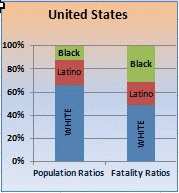Michael Brown was killed on the streets of Ferguson, Missouri, which touched off community riots. Michael was African-American. The officer who shot him was white. Frustrations and local suspicions of racially biased policing, since then confirmed by a federal investigation, had been simmering in that community for years. There have been other recent cases in the national news. There was the murder of Walter Scott of North Charleston, South Carolina, the sad shooting death of 12-year-old Tamir E. Rice of Cleveland, Ohio, and the chokehold death of Eric Garner in New York, to name just a few.

Study Population Comparison with Fatalities by Race and Ethnicity
(Image by Brian T. Lynch) Details DMCA
These shocking cases have focused national attention on what seems like a rash of questionable police killings involving minority citizens. Until now, there has been no way of telling if the perception of police bias is due to media bias, statistical flukes or real patterns of differential policing in minority neighborhoods. A big question hanging in the air:
Is the use of deadly force disproportionately used in Black or Latino communities?
I can now answer that question using newly gathered data. The question can't be answered by standard government statistics. There is no mandatory or systematic reporting of police killings in America. With 17,000 law enforcement agencies acting mostly on their own, fatal encounters are seldom noticed beyond local news accounts, the bulk of these relying on local police statements. There is no public notification requirement when people are killed by police.
This is why it is a big deal that several citizens have begun scanning the internet for local news accounts of police action fatalities and compiling a listing of them on their KilledByPolice.com Website. Shocking preliminary findings showed that in just 23 months of record keeping, 2181 people were killed in police encounters. In contrast, in the past 90 years there were only 70 police killings in Great Britain.
This latest analysis only looks at three demographic categories, White (non-Hispanic), Latino and Black. All other demographic categories are excluded because they are still too few in number for a meaningful analysis. So, these three categories together represent 100% of this study population. This allows for a visual comparison. The original data includes all types of cases where a civilian is killed in a police action whether by accidental, by justified or unjustified actions.
Below are four comparative bar graphs for each of the US Census regions of the United States. It compares the distribution of the total White, Latino and Black population in the region with the distribution of people killed in police encounters within the region.
The four regional graphs above almost speak for themselves. If police action fatalities were random events then the demographic makeup of people killed should reflect the population. In every region of the country Blacks comprise a significantly larger portion of those killed in police encounters than expected, based on regional demographics. Notice also that Latino populations are over-represented among the citizens killed by police actions in the West. these regional findings were examined in more detail in this study and the data was further further examined state by state, to the extent there was enough data to search for patterns.
If the hypothesis in this analysis was to disprove that African Americans are more likely to be the casualties in fatal encounters with law enforcement, then the analysis failed to prove it.
It might still be true that there is nothing to the perception that Black Americans are more likely to die in police encounters, but the evidence here strongly suggest the contrary; that they are a disproportionate class of people killed in police encounters in virtually every region of the country. It can be said that this isn't true in every state, but that is of little comfort to minority communities.
This review of this newly collected data supports the suspicions that minority communities may be subject to differential police tactics or over-policing. The depth and breadth of these finds are disturbing. Blacks are simply more likely to be killed in police encounters in every area of the country and a majority of states. Latinos are also more likely to be among the fatalities in the West.
Fatalities in these police encounters are also overwhelmingly male. The gender basis of these findings have yet to be studied or even noticed. One might be tempted to think this higher rate of Black men being killed in police encounters is connected to so many young Black men being unemployed and on the streets, yet the average age of those killed by police is 36.9 years. This is almost exactly the average age in the U.S. population. This means there is no statistical bias due to age, which rules out a young black male theory.
Another factor some folks bring up is the high crime statistics in minority neighborhoods and a greater chance that minority folks act like criminals. First of all, there are very few crimes that carry a death sentence, which is was is administered by law enforcement where there are safer ways to apprehend a suspect. And crime statistics are mostly a sensitive measures of policing policies, tactics, training, law enforcement priorities and the culture or attitudes of those doing the policing. If you target any given group to enforce laws, their crime statistics will climb. A secondary result of economic disparity and heavy-handed policing is the contempt for the law that is often seen in poor and minority neighborhoods. The latter follows as a consequence from the former in nearly all cases.
As for minority folks acting like criminals, who is making that judgement and what is the evidence?
(Note: You can view every article as one long page if you sign up as an Advocate Member, or higher).






